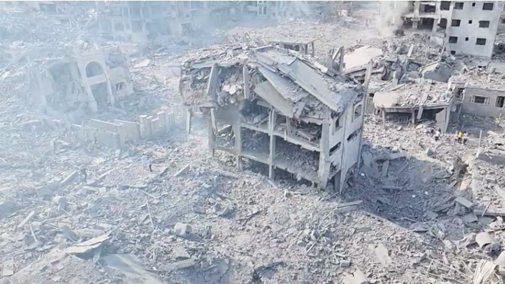Left Foot Forward
The true scandal isn’t just the right’s distortion of BBC bias, it’s the rot within the system that allowed this farce to happen.

The vultures barely waited for the body to go cold. By Monday morning, the smug right-wing press were crowing over the resignations of director general Tim Davie and News CEO Deborah Turness amid accusations of bias.
“Beeb boss quits over Trump lies,” shrieked the Sun.
“BBC bosses quit in disgrace,” cheered the Daily Mail.
The next day, they had the added bonus of plastering their front pages with Donald Trump’s threat: “Grovel – or I’ll sue you for $1 billion.”
The hysteria began in the BBC-averse Telegraph, no less, which was handed a loaded gun in the form of an internal “dossier” written by Michael Prescott, a former political editor of the Sunday Times turned PR executive. Until June this year, Prescott sat as an independent adviser to the BBC’s Editorial Guidelines and Standards Board.
The 19-page document, sent to the BBC board, alleged “serious apparent bias,” including “rogue LGBT+ reporters” censoring debate on trans issues, BBC Arabic giving “extensive space” to Hamas, and, its smoking gun, that Panorama had doctored a Trump speech to make it appear that Trump had encouraged violence on January 6.
Prescott’s anti-BBC report contains doctored quote
As the right took the moral high ground over Panorama’s allegedly misleading edit of Trump’s Capitol Hill speech, a new twist in the fast-moving story revealed that Prescott’s own report contains misleading quotes.
In the document, Prescott writes:
“Fifteen minutes into the speech, what Trump actually said: ‘We are gonna walk down to the Capitol and I’ll be with you. I know that everyone here will soon be marching over to the Capitol building to peacefully and patriotically make your voices heard.’ It was completely misleading to edit the clip in the way Panorama aired it.”
However, as James Ball reports in the New World, this is not what Donald Trump actually said. Prescott has heavily edited the remarks, altering their meaning.
Ball also explains how just as Prescott notes that television has rules requiring broadcasters to make clear when a quote has been edited or abridged, the same standards apply in print. When shortening a quotation, an ellipsis should be used. Prescott has not done so.
“In a fair world, Prescott’s apparent error would be seen as at least as serious as the original supposed mistake made by Panorama,” writes Ball.
And just as revealing as what the dossier included is what it left out. There’s no mention of the corporation’s coverage of politics, business, education, health, the royal family, domestic affairs, climate change, crime, or even Ukraine.
“Did Prescott ever think to ask whether the same objections that he raised over the treatment of Trump might be applied to the BBC’s treatment of Putin?” asks journalist David Aaronovitch in an op-ed in the Observer that questions the impartiality of the document at the heart of the controversy. .
“So Prescott zeroes in on the culture war plus Gaza agenda. Because these seem to be the things that bother him, not because these are all the things a conscientious adviser might be bothered by,” he adds.
Prescott’s dossier is looking less and less like a whistleblower’s warning and more and more like a political grenade.
Prescott bailed out of journalism 24 years ago for a lucrative career in corporate PR and serves as managing director at Hanover Communications, a PR company with links to the Conservative party. Official EU and UK lobbying disclosures seen by Byline Times show Hanover represents a number of US tech and entertainment giants, including Oracle, Apple, Meta and Paramount. Oracle’s co-founder Larry Ellison, a Trump ally and Republican megadonor, who recently briefly overtook Elon Musk as the world’s richest man, helped build the pro-Trump Heritage Foundation’s ‘Project 2025’ personnel database for a future Trump administration. Ellison’s son David now chairs Paramount Skydance, following a merger with the entertainment powerhouse that owns CBS.
And it gets worse.
Prescott’s post on the BBC’s editorial board was reportedly secured under the influence of Sir Robbie Gibb, BBC board member and co-founder of GB News.
Gibb’s fingerprints are everywhere. A self-described “Thatcherite Conservative” and former Downing Street communications chief under Theresa May, now sits in judgment over BBC impartiality. Trump, according to his lawyer, is “very fond” of GB News’s “fair and accurate reporting.” Its co-owner hedge fund multimillionaire Paul Marshall, who also owns the Spectator and UnHerd, has previously called for the BBC to be sold, describing it as squatting “like a giant toad in the middle of the UK media landscape.”
The right’s punching bag
For years, the BBC has been the right’s favourite punching bag, too ‘woke,’ too ‘globalist,’ too unwilling to parrot the culture war lines coming out of Westminster and Mar-a-Lago alike.
Davie’s resignation was the scalp they’d been waiting for.
Never mind the details, the facts, that Senate, Congressional and legal investigations into Trump’s conduct on January 6 concluded he bore responsibility for the insurrection that followed.
Just slap ‘disgrace’ across your front page and tell your readers you ‘told them so.’
Yes, Panorama made an error. The failure to re-edit a mis-spliced Trump clip was serious, but hardly a scandal of world-historical proportions. As Sky’s former political editor Adam Boulton observed, summarising long speeches through edits is standard practice, and the overall impression that Trump encouraged the riots, was correct.
Yet when the Murdoch-owned Times publishes a fake interview with a former New York mayor during an election campaign, no one called for heads to roll. The Murdoch empire has spent decades attacking the BBC, while paying billions to settle phone-hacking and corruption cases.
This crusade isn’t about media standards, it’s about power.
And never mind that the Telegraph, the very paper that has fanned the outrage, is mired in its own chaos. Its long-running sale saga, tangled in political interference and editorial controversy, remains as turbulent and uncertain as ever.
And the Daily Mail, that immigrant-baiting, NHS-undermining tabloid, never apologised for its fabricated “Beergate” story that falsely accused Keir Starmer of breaking lockdown rules with a pre-pandemic photo.
Where were the cries of “fake news”? Where were the demands to “grovel or be sued”? Interestingly the most recent survey that I’ve seen, finds that while 60% of people trust the BBC for their news, that falls to 24% for the Mail.

Which brings us on to Boris Johnson. The former prime minister who was actually found guilty of breaking lockdown laws, urged readers in his Mail column to boycott the licence fee unless Tim Davie offered a “convincing explanation” for its supposed bias. The corporation, he thundered, had been “caught red-handed in multiple acts of left-wing bias.”
This is the man who tried to install Paul Dacre, the former Daily Mail editor, as chair of Ofcom, the UK’s supposedly independent media regulator. Dacre, a long-time scourge of the BBC, bombed his interview so spectacularly that even a government eager to please the press couldn’t save him. Despite efforts to give him a second chance, he eventually withdrew.
Analyses that ‘sinks without a trace’
And while the right scream “leftist bias,” evidence points the other way. A Cardiff University study found Reform featured in 49 BBC News at Ten bulletins between January and July this year, whereas the Lib Dems, who have 72 MPs, featured in just 35 bulletins.
The Centre for Media Monitoring found BBC coverage of Israel’s war on Gaza gave Israeli deaths 33 times more attention per fatality than Palestinian ones. As Politico’s editor Alan Rusbridger notes: “Such analyses tend to sink without trace. Is this, in itself, a form of bias?”
Rusbridger raises another crucial point – who exactly sits on the BBC board, the body that received Prescott’s “dossier.” Of its 13 members, which according to Prescott dismissed his concerns, five, including chair Samir Shah, are appointed by the government. The rest are heavy on business and private equity backgrounds but light on journalism.
The committee overseeing editorial standards is equally conflicted. Three insiders, Shah, Davie, Turness, sit alongside Gibb and former BBC COO Caroline Thomson. Prescott, notably, served as an adviser to this same group. It’s an uncomfortable tangle of those enforcing standards and those accused of breaching them, a “motley bunch,” as Rusbridger describes it.
Gibb’s record speaks for itself. In 2020, he helped lead a consortium to buy the Jewish Chronicle, a paper accused of, on occasion. publishing fabricated stories about Israel’s war in Gaza. Several senior columnists resigned from the newspaper this year, including Jonathan Freedland, who said the paper “too often reads like a partisan, ideological instrument, its judgments political rather than journalistic.”
Yet Gibb remains a supposed arbiter of impartiality within the BBC, appointed by Boris Johnson and confirmed by Rishi Sunak.
Who guards the guardians?
So who guards the guardians? As Rusbridger put it: “If I were a BBC journalist, under such intensive scrutiny and fire, I’m not sure I would be terribly comforted by these governance arrangements…. I’d wonder why such close editorial scrutiny should have been entrusted to three key people who themselves rejected journalism in order to enjoy lucrative careers in corporate and political communications. Who, bluntly, would you trust more to be impartial on the Middle East—Robbie Gibb, Michael Prescott or Lyse Doucet? Why should the PR professionals who turned their own backs on journalism sit in judgment on the latter?”
Meanwhile, Donald Trump grins like the cat who got the cream. In a statement praising the Telegraph for “exposing” BBC corruption, his team declared the corporation “100% fake news.”

The true scandal isn’t just the right’s distortion of BBC bias, it’s the rot within the system that allowed this farce to happen. Prescott’s dossier, leaked from within and weaponised by the press, shows how corporate lobbyists and political operatives have captured the very machinery of media accountability.
Outside Broadcasting House stands a statue of George Orwell, inscribed with his words: “If liberty means anything at all, it means the right to tell people what they do not want to hear.”

The irony is gut-wrenching. Those who claim to defend truth are the ones strangling it. If they succeed, we may as well take the statue down.
The question remains: will ‘Auntie’, unlike the American broadcast media, be bold enough not to cower to Trump and his demands? As Alan Rusbridger observes, there’s only one way for the BBC to salvage some dignity from the smoking rubble of the past week – with a four-word message: “See you in court.”
Left Foot Forward
"I think people need to see through Nigel Farage, and see through Donald Trump and realise what they’re trying to do to our great country."

Lib Dem leader Ed Davey has slammed Nigel Farage for joining in with Donald Trump’s attacks on the BBC.
Trump has threatened the BBC with a $1 billion lawsuit after it resurfaced that a BBC Panorama documentary had spliced together two clips from a Trump speech to make it look like he had encouraged the January 2021 Capitol riot.
On Sunday night, the BBC’s director general Tim Davie and BBC News’ CEO Deborah Turness resigned.
Farage claimed during a Reform press conference yesterday that the BBC had stitched Donald Trump up “on the eve of a national election” by airing the Panorama episode.
In Trump’s speech on January 6 2021, he said: “We fight like hell. And if you don’t fight like hell, you’re not going to have a country anymore.”
This line in Trump’s speech has been repeatedly pointed to as evidence of him having incited the riots.
The Reform leader mentioned having spoken to Trump on Friday, who he said was angry at the BBC.
Farage then went on to attack the BBC: “I mean people talk about election interference, what the BBC did was election interference.”
He also said that if Reform wins power at the next election, he will “defund the BBC from its current model, be in no doubt about that”.
“The licence fee, as currently is, cannot survive, it is wholly unsustainable,” Farage, who has a GB News show, added.
On Sky News, Davey said condemned the Reform leader’s comments.
Davey said: “Nigel Farage is basically teaming up with Trump to criticise the BBC, it’s shocking, it’s unpatriotic, it’s wrong. It shows he wants Trump’s America, with his attacks on free media, coming to the UK.”
Asked if he understood why Farage had said the BBC committed “election interference”, Davey said that comment was “too extreme”. He said: “The interference we have seen in elections has come from Nigel Farage’s friend Vladimir Putin.”
He said that Russia has interfered with UK elections in the most “appalling ways”, yet Farage calls Putin “the world leader he most admires”.
“I think people need to see through Nigel Farage, and see through Donald Trump and realise what they’re trying to do to our great country.”
The Lib Dem leader has written to prime minister Keir Starmer, Tory leader Kemi Badenoch and Farage calling on them to condemn Trump’s attack on the BBC.
He has also called for BBC board member Robbie Gibb, who was appointed by Boris Johnson and is a longstanding Tory supporter, to be removed from the board.
Reports have suggested that Gibb “led the charge” in claims over systemic bias at the BBC.
Speaking on Times Radio on Tuesday, shadow culture secretary Nigel Huddleston said the BBC must pull out all the stops to avoid leaving licence fee payers facing a huge legal bill.

Senior Tories have been criticised for saying that the BBC should apologise to President Trump after he threatened to sue the corporation after it edited one of his speeches.
The Republican has threatened to sue the BBC for $1 billion, following claims Panorama “doctored” footage of a speech he made to his supporters before the Capitol riots on January 6, 2020.
The BBC has apologies with two of its top figures, including the director-general, resigning amid concerns about impartiality – notably the editing of a Panorama documentary from October 2024.
The corporation has until Friday at 10pm to respond to the president’s legal threat, however given that the documentary was not aired in America, legal experts believe Trump’s chances of success are limited. However, that hasn’t stopped senior Tories from demanding the BBC grovel and apologise to Trump.
Speaking on Times Radio on Tuesday, shadow culture secretary Nigel Huddleston said the BBC must pull out all the stops to avoid leaving licence fee payers facing a huge legal bill.
He said: “If you look at the complaint he’s got, the TV programme, the Panorama programme, he probably has legitimate claims to say, look, this was wrong and definitely requires and demands an apology. So I would advise the BBC to grovel here.
“They need to make sure that they communicate very clearly that they got this wrong and that they apologise. And then I think probably we need to all appeal to Donald Trump to make it clear that it’s licence payers, it’s taxpayers, that would suffer then because of the bad and poor decisions made by a bunch of left-wing journalists and anti-Trump journalists and make it clear that they should be the ones held to account.”
Asked later how the BBC should respond, Nigel Huddleston told GB News: “Well, with a big apology and grovel because they were wrong, and Donald Trump has a perfectly legitimate concern here. It wasn’t could be perceived to be misleading, it transparently was.”
Social media users were quick to criticise Huddleston’s comments, with one user writing: “Just watched this pathetic specimen on Sky News. If the likes of Nigel Huddleston was in office, Trump may as well be installed as UK President. What a grovelling little shit.”
Another added: “Thank God this moron is only the Shadow culture secretary otherwise his actions would humiliate us on the world stage. Do not give an inch to the corrupt, lying scumbag Trump – the BBC should apologise for the edit but that’s it, there is no case to answer beyond that.”
"This is the most abysmal, pathetic thing. The BBC head resigning because the corporation is not supine *enough* to the far-right."

The UK right-wing media and American right are taking delight in the resignations of the BBC’s director general, Tim Davie, and BBC News CEO Deborah Turness.
The Telegraph has published a series of attack lines against the BBC over the last week.
First, they reported that an internal BBC memo written by ex-Murdoch journalist Michael Prescott which raised concerns that Panorama footage put two parts of a Donald Trump speech together so he appeared to encourage the Capitol Hill riot in January 2021.
Prescott also accused BBC Arabic reporters of “anti-Israel bias”.
On Friday, The Telegraph published comments from former prime minister Boris Johnson saying: “Davie must explain or quit”.
In his Daily Mail column, Johnson’s piece led with the headline: “Until BBC boss Tim Davie either comes clean on how Panorama doctored Trump’s speech – or resigns – I won’t be paying my licence fee.”
In a lengthy statement attacking the BBC, Trump thanked The Telegraph for “exposing” corruption at the broadcaster, while his press secretary Karoline Leavitt called the BBC “100% fake news”.
Trump has now threatened to sue the BBC for $1 billion.
As Sky’s former political editor Adam Boulton, pointed out, the overall impression that Trump encouraged the riots was true. Other journalists have highlighted it is common practice to “splice together” sections of a long speech to summarise it.
While right-wing critics accuse the BBC of “left-wing bias,” evidence suggests the broadcaster has given more attention to Reform UK’s MPs than to the Greens or Liberal Democrats.
A recent Cardiff University study found Reform featured in 49 BBC News at Ten bulletins between January and July this year, whereas the Lib Dems, who have 72 MPs, featured in just 35 bulletins.
The BBC has also been criticised for its reporting on Israel’s war on Gaza, with a recent Centre for Media Monitoring (CfMM) study showing that Israeli deaths are given 33 times more coverage per fatality than Palestinian deaths.
David Yelland, former editor of the Sun wrote on X: “What has happened today at the BBC is nothing short of a coup, a national disgrace, the corporation’s board has effectively been undermined and elements close to it have worked with hostile newspaper editors, a former PM and enemies of public service broadcasting. The only honourable players here are Tim Davie and Deborah Turness.”
Journalist and environmental activist George Monbiot said: “Once every 20 years or so, the director-general of the BBC is forced to resign for being insufficiently rightwing. Alastair Milne in 1987. Greg Dyke in 2004. Tim Davie in 2025. The great irony is that the BBC was in all cases profoundly biased towards established power. But just not biased enough…”.
Journalist Ian Dunt said: “This is the most abysmal, pathetic thing. The BBC head resigning because the corporation is not supine *enough* to the far-right.”
Political editor of Byline Times, Adam Bienkov, wrote on Bluesky: “The BBC’s senior leadership resigning en masse over one dodgy edit in one programme, simply because the right wing press demands it, tells you everything you need to know about where the power really lies in that relationship.”
Olivia Barber is a reporter at Left Foot Forward
By Paul Wallis
EDITOR AT LARGE
November 15, 2025

Image: - © AFP/File Justin TALLIS
In a not entirely surprising twist Trump is now saying he’ll sue the BBC for up to $5 billion. Trump says he was defamed by a somewhat iffy BBC edit of “Trump A Second Chance?” on the long-running BBC show Panorama.
The BBC has apologized but doesn’t agree with the defamation argument. Trump says the BBC is “fake news,” a term he basically coined for any and all negative press. Not much has changed.
Note: It’s unclear whether any actual formal proceedings are currently in place.
Whether or not UK law will entertain Trump’s idea of defamation is another matter. The highly litigious US is a very different legal environment to the UK. At least it’s supposed to be. The issue is what constitutes defamation and what isn’t, edits aside.
Let’s leave out the legal arguments. There is another issue here that isn’t getting much attention. The right to sue, rightly or wrongly, is not in question.
The question of such high punitive damages, however, is very much an issue that may haunt global media for decades to come.
Important: Note that a court may award damages as it sees fit, not necessarily the amount claimed by the plaintiff. Claims for damages are usually subject to intense dispute.
Can such litigation be simply thrown out by the court?
Yes, it can.
Will such a high-profile case be simply thrown out?
Very probably not.
The case would have to be heard in full, even “on principle.”
There’s an important possible legal precedent that could well affect global media.
The high-stakes damages are very much part of the bigger picture.
If this case is successful and becomes an instant legal precedent, what follows?
Where do you draw the line, let alone make the distinction, between simple reportage and someone’s personal interpretation of the same reportage?
Expect fireworks if this case proceeds.
__________________________________________________________
Disclaimer
The opinions expressed in this Op-Ed are those of the author. They do not purport to reflect the opinions or views of the Digital Journal or its members.




